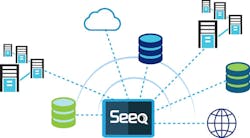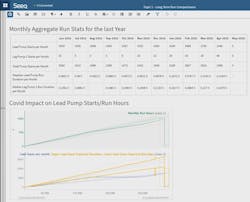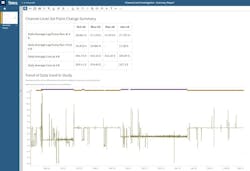Applying Advanced Analytics in the Water & Wastewater Sector
About the author:
Sean Tropsa is analytics engineer for Seeq Corp. Tropsa can be reached at [email protected].
Across industries, engineering decisions are too often made based on subjective judgements. Considering how inexpensive and easy modern automation makes it to generate and collect massive amounts of process data, the propensity to make decisions by gut feel may seem far-fetched to a bystander. For plant personnel, however, the struggle to improve upon instinct is often all too real.
Data itself does not lead to informed decision-making because it must first be carefully cleansed and analyzed to produce insights. These insights enable plant managers, operators, and engineers to make informed decisions to increase productivity, but traditional tools to perform these tasks—typically spreadsheets—have fallen behind the needs of users. Platforms such as Seeq — an advanced analytics application—address these needs by empowering end users to dig into process problems, gain insights, and make data-based decisions.
Water & Wastewater Challenges
Water districts and municipalities everywhere need to turn data into insights to fulfill their myriad responsibilities to the public by:
- Producing and distributing enough drinking water to meet demand;
- Guaranteeing water quality meets or exceeds requirements (see Figure 1 above);
- Keeping water rates low, often at pennies or fractions of pennies per gallon; and
- Ensuring sustainable water yield far into the future.
Highly-automated facilities help keep operations within acceptable process specifications, generating plentiful volumes of data but few insights. These multi-component systems can actually make it more difficult to pinpoint the cause of inefficiencies and problems due to their complexities. The data produced is not helpful to plant personnel by itself. It must be translated into a narrative, making it easy to identify where a process went wrong.
Graphs and charts displaying raw tag history can provide ideas, but advanced analytics software gives subject matter experts (SMEs) a much clearer picture. The software enables quick problem identification, along with collaboration among team members to produce and share insights. These insights empower SMEs to make informed decisions for process improvement, ultimately helping a district or municipality meet their obligations to the public.
Drowning in Data
As a byproduct of the digital transformation occurring at many water and wastewater plants, the excess of data can muddy the waters for SMEs. They sometimes do not know where to begin, and often lack the time required to navigate seas of data (see Figure 2).
Adding to the challenge, raw process data is often siloed into segregated historians, SQL databases, or comma-separated values (CSV) files. Combining records from disparate sources requires time and effort, making it arduous to piece data together, let alone analyze it. Sometimes data is aggregated into digestible daily reports, but examining it in a long-term context is problematic.
Even if an SME is able to collect all the data required to analyze a problem, it often ends up in an Excel spreadsheet. After collecting data from multiple sources, an SME can spend hours or days aligning and filtering it before finally presenting it to the rest of the team. There is a time and place for Excel, but using it to cleanse, contextualize, and calculate time-series data is cumbersome, and the entire process lacks collaboration tools.
As a result, SMEs often make gut decisions regarding plant operation. They do not have time to wrangle the required data and then analyze it because there is a plant to run, and it demands attention. As a result, SMEs cannot access data insights, and process problems go unanswered. Thoughts and hunches for improved efficiency remain unexplored, and anticipated benefits from improvement projects remain unquantified.
Gut decisions also negatively impact team dynamics. A more senior staff member may decide they know the plant better than others, leading him or her to make an operational change without data justification. Even when such changes have positive process results, they can erode team dynamics over time. Without access to shared data analytics for collective understanding and decision-making, it is easy to step on others’ toes.
Advanced Analytics
Advanced analytics software connects to all historians and data sources within a plant — including CSV files — and provides access to it as a unified experience for the user (see Figure 3), eliminating data wrangling frustration. From here, the data may be leveraged for predictive, descriptive, and diagnostic analytics, empowering users to quickly identify trends, find insights, and make decisions.
Modern advanced analytics software is web-based, empowering teams to work together on the same worksheet regardless of geographic location. Users can record notes, save views, and embed context or tribal knowledge so their work can be leveraged by others and preserved for the future. They can also:
- Quickly apply smoothing algorithms;
- Identify and account for plant downtime;
- Create models in minutes; and
- Automate report generation.
These and other functions free up valuable SME time so they can drive further plant improvements. Additionally, coworking capabilities increase opportunities for team collaboration and connection.
Success Stories
Prior to deploying an advanced analytics software, an SME needing to access water quality data spent hours combing through CSV files to extract raw data. In addition to joining data from multiple files, the SME spent time preparing the data for calculation and analysis. Advanced analytics software not only eliminated the need for this time-consuming work, but also enabled the SME to view real-time water quality calculations alongside process variable values.
Similarly, another end user was having trouble with a turbidity sensor. Advanced analytics software enabled her to identify periodic step changes in level and standard deviation that had been overlooked using prior tools for data analysis. Aggregating an additional CSV file of maintenance information into the analysis led to further insight: the step changes were occurring in conjunction with manual maintenance windows. This enabled the SME to quickly identify the problem, as well as its cause and resolution.
Seeq recently worked with a municipal water distributor that produced thorough daily pumping reports, but lacked the context needed from years of previous data. Without the ability to examine data over long periods of time, it was not possible to compare current operation with past performance. By connecting Seeq to its data, the municipal water distributor was able to delve into historical trends, aggregate periods of interest, and easily overlay months or years of data to directly compare current and past trends.
The team at this facility was even able to characterize the impact on equipment through the Covid-19 crisis, showing there were fewer pump starts and stops due to lower variance in water demand by time-of-day during lockdown (see Figure 4).
In another case, Seeq confirmed an SME’s hunch regarding process improvement. Prior to deploying advanced analytics software, plant personnel had increased a channel level setpoint with the theory it would decrease the daily run time of pumps tasked with maintaining level in a tank. No effort was made to quantify the result or verify savings due to the exertion required to tease this information from available data. After deploying Seeq, the SME spent an hour preparing a full analysis of the situation before and after the setpoint change, which confirmed the modification was indeed decreasing daily pump run time, and also quantified the cost savings (see Figure 5).
Easing Data Pain
Growing weary of wrangling disparate data from different sources and creating insights using traditional tools, an increasing number of water districts and municipalities are turning to advanced analytics software, freeing up precious time to focus on process improvement, troubleshooting, and predictive maintenance. Once resigned to decisions on the fly, plant personnel can now easily and collaboratively produce analyses that tell stories, giving them the confidence to make well-informed operational decisions.
As a cloud-hosted advanced analytics application, Seeq is uniquely poised to help SMEs in the water and wastewater sector drive data analytic methodologies forward to modern times. Advanced analytics software is enabling agencies to connect to many types of data sources and transform information into insights for increased process efficiency, empowering them to deliver high-quality service to the public.
About the Author
Sean Tropsa
Sean Tropsa is analytics engineer for Seeq. Tropsa can be reached at [email protected].




